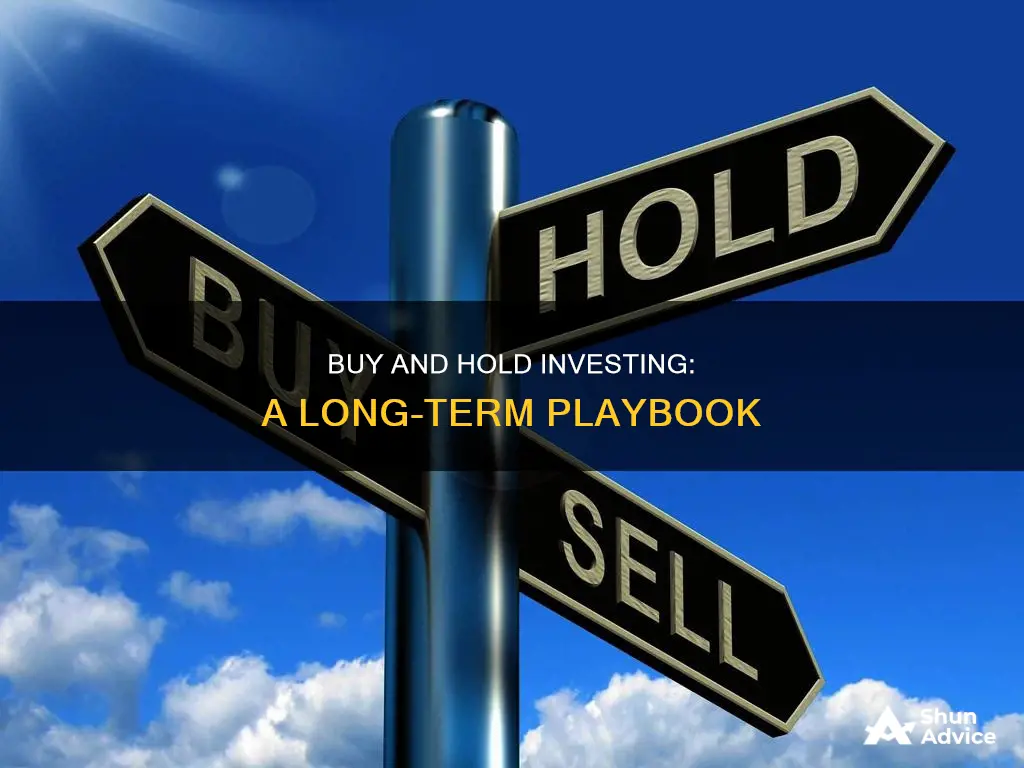
Buy and hold is a passive, long-term investment strategy where investors buy stocks or other securities and hold them for a long period, despite any market fluctuation, with the goal of price appreciation. This strategy is simple to execute: all you have to do is buy a financial security and not sell it. It is often associated with stock market investments but can be applied to other asset classes, including bonds, real estate, and certain commodities.
| Characteristics | Values |
|---|---|
| Type of Investment Strategy | Passive, long-term |
| Investor Behaviour | Actively selects investments but does not concern themselves with short-term price movements |
| Investor Outlook | Believes in the potential of their chosen assets to appreciate over time |
| Investor Psychology | Must not be affected by recency bias, emotions, and must understand their propensity to risk aversion |
| Investor Action | Does not engage in market timing |
| Investor Taxes | Can defer capital gains taxes on long-term investments |
| Investor Risk | Critics argue that investors may not sell at optimal times |
| Investor Performance | Outperforms active management, on average, over longer time horizons and after fees |
| Types of Assets | Stocks, bonds, real estate, commodities, ETFs, mutual funds |
What You'll Learn

Buy-and-hold vs active investing
Buy-and-hold investing is a passive, long-term investment strategy. An investor using this strategy buys stocks or other securities and holds them for a long period, sometimes decades, regardless of fluctuations in the market. The idea is that the investor lets their money increase with the growth of the overall market, making only occasional changes to their portfolio.
This strategy is simple to execute but requires confidence that the value of the investments will be higher in the future. It also demands a solid psychological commitment, as investors must not be affected by emotions or recency bias and must understand their risk aversion.
Critics of the buy-and-hold strategy argue that investors may not sell at optimal times and that there is no opportunity to profit from market volatility.
Active investing, on the other hand, involves buying and selling securities in response to company-specific or broad market news. It attempts to profit from shorter-term price movements, typically lasting less than a year. Active investors sell stocks according to what's happening in the stock market, buying when prices are low and selling when prices are high.
While active investing can be successful, it also involves a deeper level of analysis and a higher number of decisions, which can lead to more transaction costs.
Both strategies have their advantages and disadvantages, and the choice between them depends on an investor's financial goals, risk tolerance, and investment horizon.
Invest More, Earn More: The Power of Commission Dominance
You may want to see also

The importance of research
The buy-and-hold investment strategy is a passive approach where investors buy stocks or other securities and hold them for long periods, ignoring short-term price fluctuations and technical indicators. While this strategy offers simplicity and tax benefits, it is important to conduct thorough research before investing. Here's why:
- High-Quality Companies: Buy-and-hold investors seek to own shares of outstanding companies with strong business fundamentals and management. Research helps identify such companies, ensuring that the investment thesis remains intact over time.
- Long-Term Performance: Buy-and-hold is a long-term strategy, and historical data shows that equities tend to provide higher returns over longer periods. Researching and understanding market trends and historical performance can provide valuable insights into potential long-term gains.
- Risk Mitigation: While buy-and-hold investors ignore short-term volatility, research is crucial to identify and mitigate risks. Proper research helps investors avoid companies with weak fundamentals or management issues, reducing the likelihood of significant losses.
- Tax Advantages: Buy-and-hold investors can benefit from tax deferral on capital gains. However, understanding the tax implications and conducting research to time their purchases and sales optimally can further enhance their tax efficiency.
- Avoiding Costly Mistakes: Without proper research, there is a risk of buying high and selling low. Studying companies' fundamentals, growth prospects, and management capabilities helps make more informed decisions, reducing the chances of costly mistakes.
- Identifying Blue-Chip Stocks: Blue-chip stocks, or well-established companies with strong track records, are favoured by buy-and-hold investors due to their longevity and resilience. Research helps identify these stable companies, such as Coca-Cola or Johnson & Johnson, that are likely to survive economic downturns and rebound.
- Suitability for Individual Investors: Buy-and-hold investing may not be suitable for everyone. Researching and understanding an individual's financial goals, risk tolerance, and investment horizon helps determine if this strategy aligns with their needs.
In conclusion, while the buy-and-hold strategy offers a passive approach to investing, it is crucial to conduct thorough research to make informed decisions, mitigate risks, and maximise the potential for long-term gains.
Forging Checks: A Risky Investment Gamble
You may want to see also

Advantages and disadvantages
Buy and hold investing is a passive investment strategy where investors buy stocks or other securities and hold them for a long time, sometimes decades, regardless of market fluctuations. This strategy is simple to execute and is suited to cautious investors who want to research their investments and then stay put for a while.
Advantages
- Simplicity: It is a simple strategy to execute and does not require constant monitoring of investments.
- Minimal risk of investor error: Due to its simplicity, there is a low risk of failure from tactical errors.
- Tax efficiency: There are tax advantages to buying and holding, as long-term investments are usually taxed at a lower rate than short-term investments.
- Reduced transaction costs: By reducing the frequency of transactions, the buy-and-hold strategy minimises costs such as brokerage fees, commissions, and taxes.
- Compound interest: The effect of compound interest is more pronounced in this strategy, as returns can be reinvested, leading to exponential growth.
- Riding out market volatility: This strategy allows investors to ride out market volatility, a common feature in financial markets.
- Accessibility: Long-term investing is more accessible to investors with limited time or expertise to engage in frequent trading.
Disadvantages
- Poor risk management: Some buy-and-hold investors neglect to implement risk management strategies, such as rebalancing their portfolios, and may be susceptible to buying high and selling low.
- Missing out on gains: Critics argue that buy-and-hold investors may miss out on gains by not selling at optimal times and riding out volatility instead of locking in returns.
- Psychological challenges: This strategy requires a solid psychological commitment, as it can be challenging to maintain confidence during market downturns or when witnessing others profit from short-term trading.
- No profiting from market volatility: Buy-and-hold investors cannot take advantage of market volatility to buy more shares when prices are low.
Overall, the buy-and-hold strategy is a passive, long-term approach that aims to generate higher returns over time. It has several advantages, including simplicity, tax efficiency, and reduced transaction costs. However, there are also disadvantages, such as the potential for missing out on gains and the psychological challenges of staying committed to the strategy during market downturns.
AMC Stock: Invest or Avoid?
You may want to see also

Tax benefits
One of the benefits of buy-and-hold investing is that investors can typically defer capital gains taxes. This is because any profit made from the sale of an asset held for longer than a year is subject to long-term capital gains tax, which is taxed at a lower rate than short-term capital gains tax. Long-term capital gains tax rates are 0%, 15%, or 20%, depending on the investor's taxable income and filing status. In contrast, short-term capital gains are taxed as regular income, with rates of up to 37%.
Additionally, holding stocks for the long term can result in lower fees. When investors buy and sell stocks regularly, they incur transaction fees and ongoing account maintenance charges, which can add up over time. By holding stocks for the long term, investors can avoid or reduce these fees.
Another tax benefit of buy-and-hold investing is that it allows investors to benefit from compound interest. Compound interest is interest calculated on the principal balance of an investment and any earlier interest earned. By reinvesting dividends, investors can increase the amount in their account over time.
Buy-and-hold investing can also help investors avoid making emotional decisions that may negatively impact their returns. Many investors tend to withdraw their money when the market falls to avoid further losses and only buy back in once most of the gains have already been achieved. This "buy high, sell low" behaviour tends to cripple investor returns. By adopting a buy-and-hold strategy, investors can avoid making impulsive decisions and give their investments time to recover from any short-term losses.
Dividend Rewards: Exploring the World of Investment Dividends
You may want to see also

Risk management
Diversification:
Diversification is a fundamental principle in risk management. By diversifying your portfolio across different asset classes, sectors, and geographies, you reduce the impact of any single investment's poor performance. A well-diversified buy-and-hold portfolio typically includes a mix of stocks, bonds, real estate, and other asset classes. This ensures that a downturn in one area won't disproportionately affect your entire portfolio.
Regular Review and Rebalancing:
While buy-and-hold investors take a long-term view, it's still important to regularly review and rebalance your portfolio. Markets and investments evolve, and it's crucial to ensure your portfolio remains aligned with your investment goals and risk tolerance. Establish a rebalancing strategy, including how often to rebalance (annually, semi-annually, etc.) and under what conditions, such as when an asset class deviates from its target allocation.
Understanding Market Volatility:
Buy-and-hold investors must accept that short-term market volatility is inherent in any investment strategy. During periods of market downturn, it's essential to maintain a long-term perspective and not make impulsive decisions. Understand the factors that drive market volatility, such as interest rates, inflation, global economic conditions, and political events, and their potential long-term impacts on your investments.
Psychological Factors:
The buy-and-hold strategy requires a strong psychological commitment. It can be challenging to maintain confidence in your investments during market downturns or when witnessing others profit from short-term trading. Cultivating a disciplined, patient mindset focused on long-term objectives is essential. Emotional reactions to short-term fluctuations can lead to impulsive decisions that deviate from your investment plan.
Risk Tolerance and Financial Goals:
By implementing these risk management strategies, buy-and-hold investors can better navigate the inherent risks associated with investing and improve their chances of achieving their long-term financial goals.
Understanding Investment Fees: Uncovering the True Cost
You may want to see also







